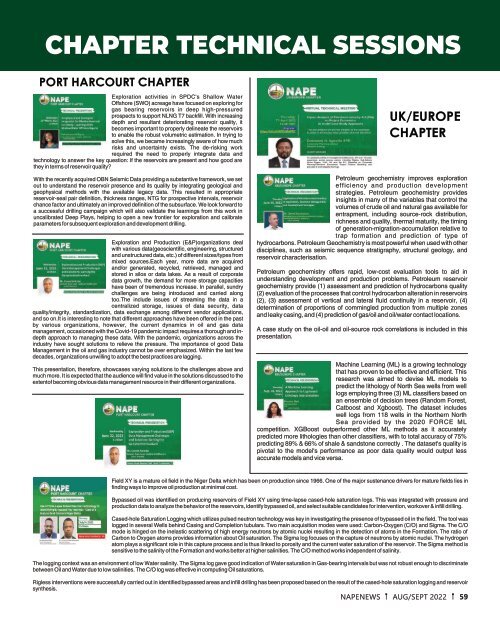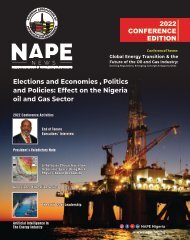Create successful ePaper yourself
Turn your PDF publications into a flip-book with our unique Google optimized e-Paper software.
CHAPTER TECHNICAL SESSIONS<br />
PORT HARCOURT CHAPTER<br />
Exploration activities in SPDC's Shallow Water<br />
Offshore (SWO) acreage have focused on exploring for<br />
gas bearing reservoirs in deep high-pressured<br />
prospects to support NLNG T7 backfill. With increasing<br />
depth and resultant deteriorating reservoir quality, it<br />
becomes important to properly delineate the reservoirs<br />
to enable the robust volumetric estimation. In trying to<br />
solve this, we became increasingly aware of how much<br />
risks and uncertainty exists. The de-risking work<br />
required the need to properly integrate data and<br />
technology to answer the key question: If the reservoirs are present and how good are<br />
they in terms of reservoir quality?<br />
With the recently acquired OBN Seismic Data providing a substantive framework, we set<br />
out to understand the reservoir presence and its quality by integrating geological and<br />
geophysical methods with the available legacy data. This resulted in appropriate<br />
reservoir-seal pair definition, thickness ranges, NTG for prospective intervals, reservoir<br />
chance factor and ultimately an improved definition of the subsurface. We look forward to<br />
a successful drilling campaign which will also validate the learnings from this work in<br />
uncalibrated Deep Plays, helping to open a new frontier for exploration and calibrate<br />
parameters for subsequent exploration and development drilling.<br />
Exploration and Production (E&P)organizations deal<br />
with various data(geoscientific, engineering, structured<br />
and unstructured data, etc.) of different sizes/types from<br />
mixed sources.Each year, more data are acquired<br />
and/or generated, recycled, retrieved, managed and<br />
stored in silos or data lakes. As a result of corporate<br />
data growth, the demand for more storage capacities<br />
have been of tremendous increase. In parallel, sundry<br />
challenges are being introduced and carried along<br />
too.The include issues of streaming the data in a<br />
centralized storage, issues of data security, data<br />
quality/integrity, standardization, data exchange among different vendor applications,<br />
and so on.It is interesting to note that different approaches have been offered in the past<br />
by various organizations, however, the current dynamics in oil and gas data<br />
management, occasioned with the Covid-19 pandemic impact requires a thorough and indepth<br />
approach to managing these data. With the pandemic, organizations across the<br />
industry have sought solutions to relieve the pressure. The importance of good Data<br />
Management in the oil and gas industry cannot be over emphasized. Within the last few<br />
decades, organizations unwilling to adopt the best practices are lagging.<br />
This presentation, therefore, showcases varying solutions to the challenges above and<br />
much more. It is expected that the audience will find value in the solutions discussed to the<br />
extentof becoming obvious data management resource in their different organizations.<br />
UK/EUROPE<br />
CHAPTER<br />
Petroleum geochemistry improves exploration<br />
efficiency and production development<br />
strategies. Petroleum geochemistry provides<br />
insights in many of the variables that control the<br />
volumes of crude oil and natural gas available for<br />
entrapment, including source-rock distribution,<br />
richness and quality, thermal maturity, the timing<br />
of generation-migration-accumulation relative to<br />
trap formation and prediction of type of<br />
hydrocarbons. Petroleum Geochemistry is most powerful when used with other<br />
disciplines, such as seismic sequence stratigraphy, structural geology, and<br />
reservoir characterisation.<br />
Petroleum geochemistry offers rapid, low-cost evaluation tools to aid in<br />
understanding development and production problems. Petroleum reservoir<br />
geochemistry provide (1) assessment and prediction of hydrocarbons quality<br />
(2) evaluation of the processes that control hydrocarbon alteration in reservoirs<br />
(2), (3) assessment of vertical and lateral fluid continuity in a reservoir, (4)<br />
determination of proportions of commingled production from multiple zones<br />
and leaky casing, and (4) prediction of gas/oil and oil/water contact locations.<br />
A case study on the oil-oil and oil-source rock correlations is included in this<br />
presentation.<br />
Machine Learning (ML) is a growing technology<br />
that has proven to be effective and efficient. This<br />
research was aimed to devise ML models to<br />
predict the lithology of North Sea wells from well<br />
logs employing three (3) ML classifiers based on<br />
an ensemble of decision trees (Random Forest,<br />
Catboost and Xgboost). The dataset includes<br />
well logs from 118 wells in the Northern North<br />
Sea provided by the 2020 FORCE ML<br />
competition. XGBoost outperformed other ML methods as it accurately<br />
predicted more lithologies than other classifiers, with to total accuracy of 75%<br />
predicting 89% & 66% of shale & sandstone correctly . The dataset's quality is<br />
pivotal to the model's performance as poor data quality would output less<br />
accurate models and vice versa.<br />
Field XY is a mature oil field in the Niger Delta which has been on production since 1966. One of the major sustenance drivers for mature fields lies in<br />
finding ways to improve oil production at minimal cost.<br />
Bypassed oil was identified on producing reservoirs of Field XY using time-lapse cased-hole saturation logs. This was integrated with pressure and<br />
production data to analyze the behavior of the reservoirs, identify bypassed oil, and select suitable candidates for intervention, workover & infill drilling.<br />
Cased-hole Saturation Logging which utilizes pulsed neutron technology was key in investigating the presence of bypassed oil in the field. The tool was<br />
logged in several Wells behind Casing and Completion tubulars. Two main acquisition modes were used: Carbon-Oxygen (C/O) and Sigma. The C/O<br />
mode is hinged on the inelastic scattering of high energy neutrons by atomic nuclei resulting in the detection of atoms in the Formation. The ratio of<br />
Carbon to Oxygen atoms provides information about Oil saturation. The Sigma log focuses on the capture of neutrons by atomic nuclei. The hydrogen<br />
atom plays a significant role in this capture process and is thus linked to porosity and the current water saturation of the reservoir. The Sigma method is<br />
sensitive to the salinity of the Formation and works better at higher salinities. The C/O method works independent of salinity.<br />
The logging context was an environment of low Water salinity. The Sigma log gave good indication of Water saturation in Gas-bearing intervals but was not robust enough to discriminate<br />
between Oil and Water due to low salinities. The C/O log was effective in computing Oil saturations.<br />
Rigless interventions were successfully carried out in identified bypassed areas and infill drilling has been proposed based on the result of the cased-hole saturation logging and reservoir<br />
synthesis.<br />
NAPENEWS AUG/SEPT <strong>2022</strong> 59










